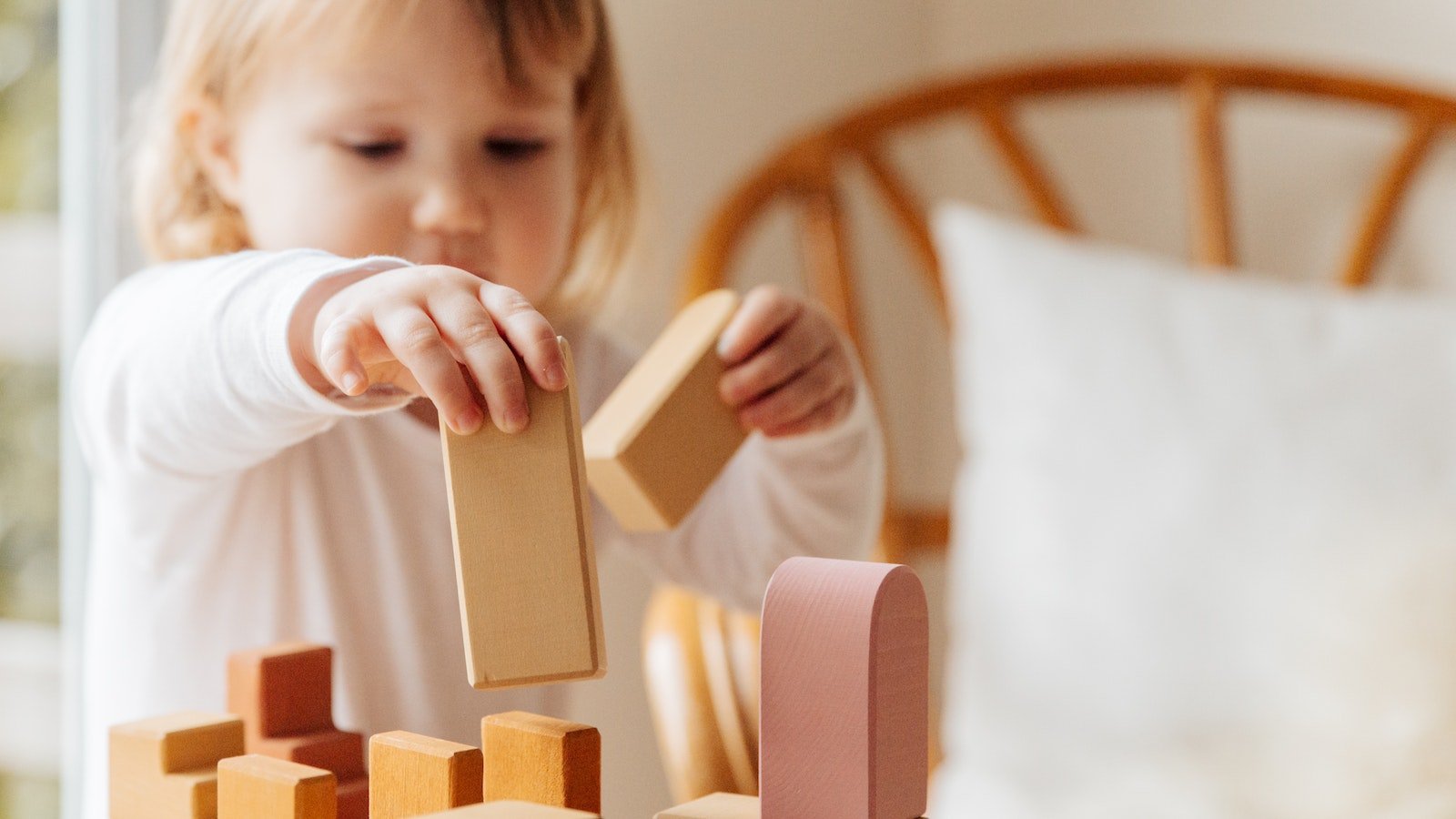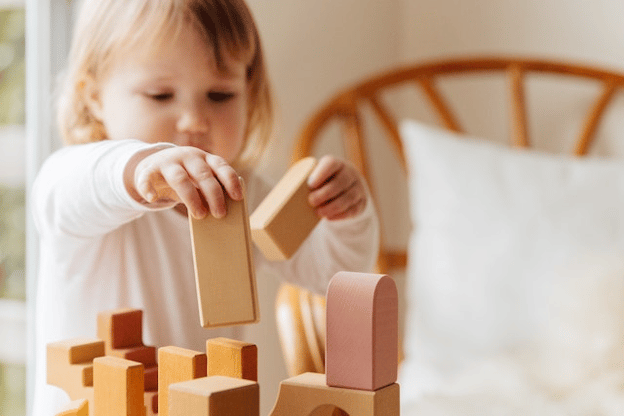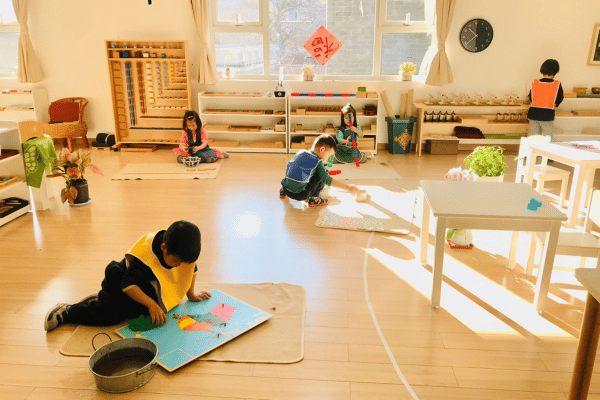
When you envision a classroom, what do you see? Many of us envision a room with a group of children sitting at desks and a teacher instructing them in front of a blackboard. For more than a century, the Montessori method has been pushing education away from this traditional model and transforming early childhood education and development to a more child-focused, self-directed approach.
In this article, you’ll learn more about the Montessori method—what it is, the pros and cons, the foundation of its curriculum, and how you can implement it in your classroom.

What is the Montessori method?
The Montessori method is an educational approach where children are guided through self-directed and self-motivated learning, activities, and play to aid in their growth in the four developmental domains of early childhood education—cognitive, language, social-emotional, and physical. It was created by Maria Montessori, an Italian physician and educator. After observing human development from birth to adulthood, she designed a whole child approach to supporting childhood development by giving children the structure and tools they need to be successful inside and outside the classroom.
The goal of the Montessori method is to create a strong foundation so children can become motivated, independent learners who eventually transition to successful adults as they continue their education and development. By providing a safe, engaging, and nurturing environment for young children, a Montessori classroom has the potential to help preschoolers develop trust in themselves and the world, grow confidence in their skills, and gain independence.
To establish the Montessori method in the classroom, the American Montessori Society recognizes five core components of Montessori education:
- Trained Montessori teachers: A properly credentialed Montessori teacher has the skills and expertise to implement high-fidelity Montessori programs.
- The multi-age classroom: Classes with three-year age spans facilitate mentorship among the children and encourage leadership development.
- Using Montessori materials: A hallmark of Montessori is specially designed materials that provide a hands-on approach to learning.
- Child-directed work: Children are given agency to self-select work, leading to intrinsic motivation and sustained attention.
- Uninterrupted work periods: An extended period of “free choice” enables children to work at their own pace and without interruption.
By the time preschool-age children enter a Montessori classroom, they’ve started developing the foundations of their personality and skills. A trained Montessori educator takes the lead at this stage to create an environment where a classroom of multi-age children can continue developing and strengthening their abilities. This environment is meant to support self-directed learning with materials and activities that target social skills, language and literacy development, mathematical concepts, and more.
The child-focused ideology of the Montessori method sets up the opportunity for children to learn through real-life activities, object manipulation, and open-ended exploration. They are free to follow their interests, choose their activities, strengthen their attention and concentration, and engage at their own pace.
Montessori school pros and cons
In a Montessori classroom, the staff plays a significant role in how impactful and successful the experience is for children and families. And like all education frameworks, implementing the Montessori method has benefits and drawbacks.
Pros
Montessori promotes self-paced, independent learning
Three of the five core components of Montessori education are Montessori materials, child-directed work, and uninterrupted work periods. When children have uninhibited access to materials and can control how and how long they use them, this gives them time to learn at their own pace and figure things out. This allows you to create opportunities for them to strengthen their independence and build their confidence as they direct their learning.
Montessori strengthens communication skills
Although the Montessori method focuses on self-directed learning, it can help children strengthen their communication skills. In a multi-age classroom, older children can help younger ones. This added opportunity for peer-to-peer learning can increase social interaction in a way that might not be seen in a classroom of same-age children.
Montessori fosters a love for learning
When education is set up to be engaging and child-directed, it creates curious learners. They appreciate the chance to develop their interests and figure things out on their own. The Montessori method can help children develop the self-motivation to learn, creating a love for learning that’s intrinsic and a lifelong characteristic that follows them into adulthood.
Montessori supports special needs
During her life, Maria Montessori’s work included research on intellectual and developmental disabilities. It should come as no surprise that her work and the Montessori method can benefit and support children with special needs. Because this “follow the child” approach creates an individualized learning path for children, it can easily be adopted to work for all children, despite their needs. Additionally, Montessori programs can provide more stability for children with special needs because they can spend up to three years in a classroom with the same teacher.
Cons
Montessori is expensive
Montessori education relies heavily on high-quality learning materials. Add that to the time and depth it takes to train educators in using these tools, and you’ll find that it’s hard to keep the costs of a Montessori education low. The cost not only affects operating costs at your school, but it can also trickle down to families. For example, Montessori preschools can cost between $10,000 and $15,000 a year, depending on the location. Because the Montessori method sets up classrooms of multi-age children with three-year age spans, parents may be paying these tuition payments for several years.
Montessori is not accessible to everyone
Unlike public schools, most Montessori schools are privately-run. Additionally, they charge tuition and regulate admissions. This makes it harder for low-income, inner-city children to attend Montessori programs. This imbalance makes the method appear designated for white, privileged children, despite the actual vision of Montessori being a framework for all children.
Montessori can be inconsistent
Although Maria Montessori’s book The Montessori Method introduces and describes her educational approach, the name is not trademarked. What does this mean? Any school or program can claim to be Montessori-based. Not only is it impossible for families to evaluate whether the program follows Dr. Montessori’s standards, but it also makes teacher training evaluation difficult.
When early childhood education programs adopt the Montessori method, they often make changes—using shorter work periods, adding special classes, introducing extra activities, and using additional learning materials—to fit their needs. And while one could argue that teachers should have the freedom to tweak their curriculum, this can make Montessori implementation inconsistent.
Montessori sacrifices collaboration for independence
Supporting independence is inarguably a benefit of the Montessori method, but one criticism is that it pushes too much independence at the expense of collaboration and teamwork. Montessori classrooms push individualized learning, allowing children to work at their own pace and direct themselves. The curriculum doesn't intrinsically include collaboration. While this might not affect children during their Montessori education, the ability (or inability) to work with others will affect them as they continue their education and eventually transition into employment.
What are the five principles of the Montessori method?
Using her experience as a doctor and educator, Maria Montessori built the Montessori method on five basic principles:
- Principle 1: Respect for the child
- Principle 2: The absorbent mind
- Principle 3: Sensitive periods
- Principle 4: The prepared environment
- Principle 5: Auto-education
Principle 1: Respect for the child
The Montessori method emphasizes respecting children and their learning process. Every child has strengths, weaknesses, abilities, disabilities, or needs. Respect for the child prioritizes children and requires educators to take a step back from providing absolute direction. Instead, the Montessori method calls for teachers to show respect for the child by giving them free choice in their learning. Respect is shown by not interrupting their work or concentration. Montessori programs reshape how one might look at traditional education standards by demonstrating that children should be respected and allowed to thrive on their own.
Principle 2: The absorbent mind
Children have “absorbent minds.” From birth to preschool age, children experience intense mental activity that allows them to absorb information from their environment quickly and easily, without conscious effort. Consider how easy it seems for young children to learn multiple languages at one time. Simply by living and experiencing, their absorbent minds are constantly helping them learn.
Principle 3: Sensitive periods
Sensitive periods are described as specific times during development when children are ready and receptive to acquiring a specific skill or ability. They are particularly sensitive to information and stimuli that promote the development of that skill. For example, there are periods when children are sensitive to learning a language or counting. The order and timing of sensitive periods are different for each child. Therefore, Montessori teachers are trained to observe children so they are able to identify sensitive periods and prepare the environment to meet the children’s needs.
Principle 4: The prepared environment
During early childhood, children move through different stages of development. As they move through these stages, their needs change. In a Montessori classroom, the teacher is responsible for creating “the prepared environment.” They achieve this by carefully selecting and arranging materials in sequential order to meet the developmental needs of the children. By preparing the classroom, Montessori educators can foster a child’s growth and ability to progress at their own pace by creating a space that allows them to do things on their own.
Principle 5: Auto-education
The auto-education principle of Montessori suggests that children learn best when they are allowed to figure things out for themselves. While teachers provide guidance, encouragement, and the proper environment, the children educate themselves.
Montessori curriculum
With approximately 5,000 schools in the United States and more than 20,000 schools across the world, the Montessori method is one of the most popular types of preschool curricula in early childhood education. Intentional curriculum and lesson planning are necessary to create a stimulating and successful Montessori environment.
To implement the Montessori curriculum, educators present lessons to the children. After a lesson, children are presented with the materials they need to independently explore, learn, and make connections to fulfill learning objectives. As the children explore, educators observe. While intervention might be necessary, this is an opportunity to encourage independence and empower children to learn new information and skills while documenting their progress.
Before you can implement Montessori practices in the classroom, the first step is to create a Montessori curriculum. It should offer children five key areas of learning: practical life, sensorial, mathematics, language, and cultural studies.
Practical life
Practical life is a Montessori term that covers domestic work, where young children learn to take care of themselves and their environment. Practical life exercises resemble everyday activities. These are the skills needed to maintain the home and classroom, practice self-care and personal hygiene, and demonstrate grace and courtesy. Practical life activities are meant to help develop a child’s fine and gross motor skills as well as their independence, confidence, self-control, and self-awareness.
Examples of practical life exercises include hand washing, gardening, cooking or food preparation, and sweeping.
Sensorial
The sensorial area of a Montessori curriculum should help children develop and refine their senses—sight, hearing, taste, touch, and smell. It’s needed to help them understand and adapt to their environment. Working with sensorial materials can help children build a foundation for language, literacy, and math. The materials help children isolate qualities like shapes, colors, and sizes and distinguish between smells, tastes, and sounds, helping them learn sorting, classifying, and organization.
Mathematics
The math curriculum of Montessori is designed to teach children mathematical concepts, such as recognizing numbers and counting, learning the concept of big and small, and sorting, through hands-on experiences. It creates the foundation for further and later exploration of more advanced ideas where children will eventually learn more concrete and abstract information. Math exercises are meant to build on each other and should allow children to grow and progress at their own pace.
Examples of math materials used in Montessori classrooms include spindle boxes, number rods, and number tiles.
Language
One of the beliefs of the Montessori method is that children are born with what they need to develop language. Because of their absorbent minds, they require very little to absorb language. The Montessori language curriculum focuses on developing a child’s innate skills and using that as the foundation to build their listening, comprehension, and vocabulary skills. This area of the curriculum is also designed to help children develop their reading, writing, and oral language.
The language curriculum should help children experience language in different ways, whether that’s by learning letter sounds, practicing how to hold a pencil, or experiencing social interactions.
Cultural studies
The cultural curriculum of the Montessori method is designed to help children learn and understand their place in the world. By incorporating topics such as science, history, art, and music, children are introduced to diversity, social responsibility, and more. Cultural exercises allow children to explore the world beyond their classroom and home and gain an appreciation for people and their differences.
Building a high-quality Montessori curriculum requires intention, pre-planning, and the right tools. A tool like brightwheel’s lesson plan software is designed to help you save time with its complete, easy-to-implement curriculum system and customized learning standards you can cater to meet the needs of your program.
Montessori classrooms
Whether you’re operating a childcare center or planning to start a preschool at home, your classroom design affects the success of your program. Montessori classrooms don’t look or feel like typical classrooms. Traditional classrooms can look cluttered and feel like a sensory shock with tons of bright objects and colors. Montessori classrooms are designed to feel calm, comfortable, and intuitive for a child’s needs.

While educators have control over classroom design, there are several layout ideas characteristic of setting up a space that is conducive to a Montessori curriculum. Consider the following tips when designing your classroom:
- Use soft lighting. Montessori classrooms use natural lighting to create a calm environment. Additionally, natural lighting is often paired with greenery instead of bright, plastic materials.
- Limit wall decor. In early childhood education, educators may be tempted to fill classroom walls with brightly colored posters and decor. Montessori classrooms are the opposite. Decorations are kept to a minimum. They are typically simple and practical.
- Use natural furnishings. Montessori classrooms typically use natural wood furnishings.
- Create designated learning areas. Montessori classrooms should be divided into multiple learning areas dedicated to practical, sensory, math, language, and cultural experiences and activities.
- Remove the focal point. Montessori classrooms don’t have a focal point. In traditional settings, desks are often oriented to face a blackboard or whiteboard. In Montessori programs, every section of the classroom should be equally engaging. Some classrooms are set up to face the teacher’s desk, but Montessori design layouts reinforce that teachers are an extension of the learning experience, not the focus of it.
- Choose child-sized furniture. A child’s ability to self-explore is fundamental to the Montessori method. Using child-sized furniture supports this. Furniture and shelves should be low enough for children to easily access themselves.
- Use open storage. Montessori classrooms are filled with materials and equipment. Use open shelves and cupboard systems so they are displayed and are easy to reach.
Let children take control
The Montessori method is a children-led model where teachers create opportunities for children to take control of their education through self-direction and exploration. By giving children access to hands-on materials and experiences, the program promotes independence and cultivates a love of learning at an early age. While some might argue about the accessibility and inconsistency of the program, at its core, the Montessori method is an educational approach designed to help all children become independent learners and develop the skills they need to be successful.

